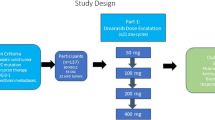Summary
Purpose Sorafenib is a multi-kinase inhibitor, which was approved as first-line treatment for patients with advanced hepatocellular carcinoma (HCC). We conducted a phase 1 study of sorafenib plus S-1 in patients with advanced HCC. Experimental design We designed to escalate S-1 at 4 different dose levels with fixed dose of sorafenib. Four dose levels were as follows: level 1, D1-14 S-1 50 mg/m2/day + D1-21 sorafenib 400 mg bid; level 2, D1-14 S-1 60 mg/m2/day + D1-21 sorafenib 400 mg bid; level 3,, D1-14 S-1 70 mg/m2/day + D1-21 sorafenib 400 mg bid; level 4, D1-14 S-1 80 mg/m2/day + D1-21 sorafenib 400 mg bid. The treatment was repeated every 3 weeks. Results From August 2009 to July 2010, 20 patients with advanced HCC were enrolled. The median age was 48 years (range, 29–74). Eighteen (90%) patients had hepatitis B viral infection and 19 (95%) patients were rated as Child-Pugh class A. The dose-limiting toxicities were grade 4 infection and thrombocytopenia. After a median follow-up duration of 8.6 months (range, 3.7–14.2 months), median PFS was 3.9 months (95% CI, 0.8–7.0 months) and median OS was 10.4 months (95% CI, 0–22.4 months). In pharmacokinetic analysis, there was no statistically significant drug interaction between sorafenib and S-1. Conclusions The combination of sorafenib and S-1 showed tolerable toxicity profile and modest clinical efficacy in patients with advanced HCC. The recommended dose of sorafenib and S-1 was 400 mg twice daily and 40 mg/m2 twice daily, respectively.


Similar content being viewed by others
References
Lee DH, Kim JH, Nam JJ, Kim HR, Shin HR (2002) Epidemiological findings of hepatitis B infection based on 1998 National Health and Nutrition Survey in Korea. J Korean Med Sci 17(4):457–462
Shin HR, Jung KW, Won YJ, Park JG (2004) 2002 annual report of the Korea Central Cancer Registry: based on registered data from 139 hospitals. Canc Res Treat 36(2):103–114. doi:10.4143/crt.2004.36.2.103
Pelletier G, Roche A, Ink O, Anciaux ML, Derhy S, Rougier P et al (1990) A randomized trial of hepatic arterial chemoembolization in patients with unresectable hepatocellular carcinoma. J Hepatol 11(2):181–184
Pelletier G, Ducreux M, Gay F, Luboinski M, Hagege H, Dao T et al (1998) Treatment of unresectable hepatocellular carcinoma with lipiodol chemoembolization: a multicenter randomized trial. Groupe CHC. J Hepatol 29(1):129–134
Lopez PM, Villanueva A, Llovet JM (2006) Systematic review: evidence-based management of hepatocellular carcinoma—an updated analysis of randomized controlled trials. Aliment Pharmacol Ther 23(11):1535–1547. doi:10.1111/j.1365-2036.2006.02932.x
Llovet JM, Bruix J (2003) Systematic review of randomized trials for unresectable hepatocellular carcinoma: chemoembolization improves survival. Hepatology 37(2):429–442. doi:10.1053/jhep.2003.50047
Chang YS, Adnane J, Trail PA, Levy J, Henderson A, Xue D et al (2007) Sorafenib (BAY 43-9006) inhibits tumor growth and vascularization and induces tumor apoptosis and hypoxia in RCC xenograft models. Canc Chemother Pharmacol 59(5):561–574. doi:10.1007/s00280-006-0393-4
Wilhelm SM, Carter C, Tang L, Wilkie D, McNabola A, Rong H et al (2004) BAY 43-9006 exhibits broad spectrum oral antitumor activity and targets the RAF/MEK/ERK pathway and receptor tyrosine kinases involved in tumor progression and angiogenesis. Canc Res 64(19):7099–7109. doi:10.1158/0008-5472.CAN-04-1443
Iyer R, Fetterly G, Lugade A, Thanavala Y (2010) Sorafenib: a clinical and pharmacologic review. Expert Opin Pharmacother 11(11):1943–1955. doi:10.1517/14656566.2010.496453
Llovet JM, Ricci S, Mazzaferro V, Hilgard P, Gane E, Blanc JF et al (2008) Sorafenib in advanced hepatocellular carcinoma. N Engl J Med 359(4):378–390. doi:10.1056/NEJMoa0708857
Cheng AL, Kang YK, Chen Z, Tsao CJ, Qin S, Kim JS et al (2009) Efficacy and safety of sorafenib in patients in the Asia-Pacific region with advanced hepatocellular carcinoma: a phase III randomised, double-blind, placebo-controlled trial. Lancet Oncol 10(1):25–34. doi:10.1016/S1470-2045(08)70285-7
Takimoto CH, Awada A (2008) Safety and anti-tumor activity of sorafenib (Nexavar) in combination with other anti-cancer agents: a review of clinical trials. Canc Chemother Pharmacol 61(4):535–548. doi:10.1007/s00280-007-0639-9
Saif MW, Syrigos KN, Katirtzoglou NA (2009) S-1: a promising new oral fluoropyrimidine derivative. Expert Opin Investig Drugs 18(3):335–348. doi:10.1517/13543780902729412
Uka K, Aikata H, Mori N, Takaki S, Kawakami Y, Azakami T et al (2008) Combination therapy of oral fluoropyrimidine anticancer drug S-1 and interferon alpha for HCC patients with extrahepatic metastases. Oncology 75(1–2):8–16. doi:10.1159/000151614
Nakamura M, Nagano H, Marubashi S, Miyamoto A, Takeda Y, Kobayashi S et al (2008) Pilot study of combination chemotherapy of S-1, a novel oral DPD inhibitor, and interferon-alpha for advanced hepatocellular carcinoma with extrahepatic metastasis. Cancer 112(8):1765–1771. doi:10.1002/cncr.23356
Morise Z, Sugioka A, Fujita J, Hoshimoto S, Kato T, Ikeda M (2007) S-1 plus cisplatin combination therapy for the patients with primary liver carcinomas. Hepatogastroenterology 54(80):2315–2318
Furuse J, Okusaka T, Kaneko S, Kudo M, Nakachi K, Ueno H et al (2010) Phase I/II study of the pharmacokinetics, safety and efficacy of S-1 in patients with advanced hepatocellular carcinoma. Canc Sci 101:2606–2611. doi:10.1111/j.1349-7006.2010.01730.x
Heim M, Sharifi M, Hilger RA, Scheulen ME, Seeber S, Strumberg D (2003) Antitumor effect and potentiation or reduction in cytotoxic drug activity in human colon carcinoma cells by the Raf kinase inhibitor (RKI) BAY 43-9006. Int J Clin Pharmacol Ther 41(12):616–617
Furuse J, Ishii H, Nakachi K, Suzuki E, Shimizu S, Nakajima K (2008) Phase I study of sorafenib in Japanese patients with hepatocellular carcinoma. Canc Sci 99(1):159–165. doi:10.1111/j.1349-7006.2007.00648.x
Abou-Alfa GK, Schwartz L, Ricci S, Amadori D, Santoro A, Figer A et al (2006) Phase II study of sorafenib in patients with advanced hepatocellular carcinoma. J Clin Oncol 24(26):4293–4300. doi:10.1200/JCO.2005.01.3441
European Medicines Agency: Sorafenib(nexavar) summary of product characteristics pp.6 [online]. Available from URL: <http://www.ema.europa.eu/docs/en_GB/document_library/EPAR>_-_Product_Information/human/000690/WC500027704.pdf
Conflict of interest disclosures
The authors made no disclosures.
Author information
Authors and Affiliations
Corresponding author
Rights and permissions
About this article
Cite this article
Lee, S.J., Lee, J., Park, S.H. et al. Phase 1 trial of S-1 in combination with sorafenib for patients with advanced hepatocellular carcinoma. Invest New Drugs 30, 1540–1547 (2012). https://doi.org/10.1007/s10637-011-9706-5
Received:
Accepted:
Published:
Issue Date:
DOI: https://doi.org/10.1007/s10637-011-9706-5




